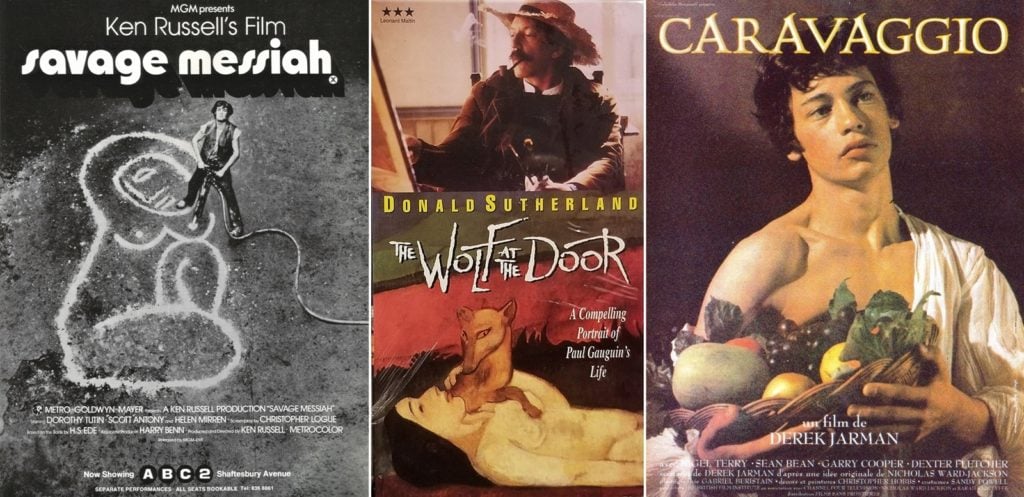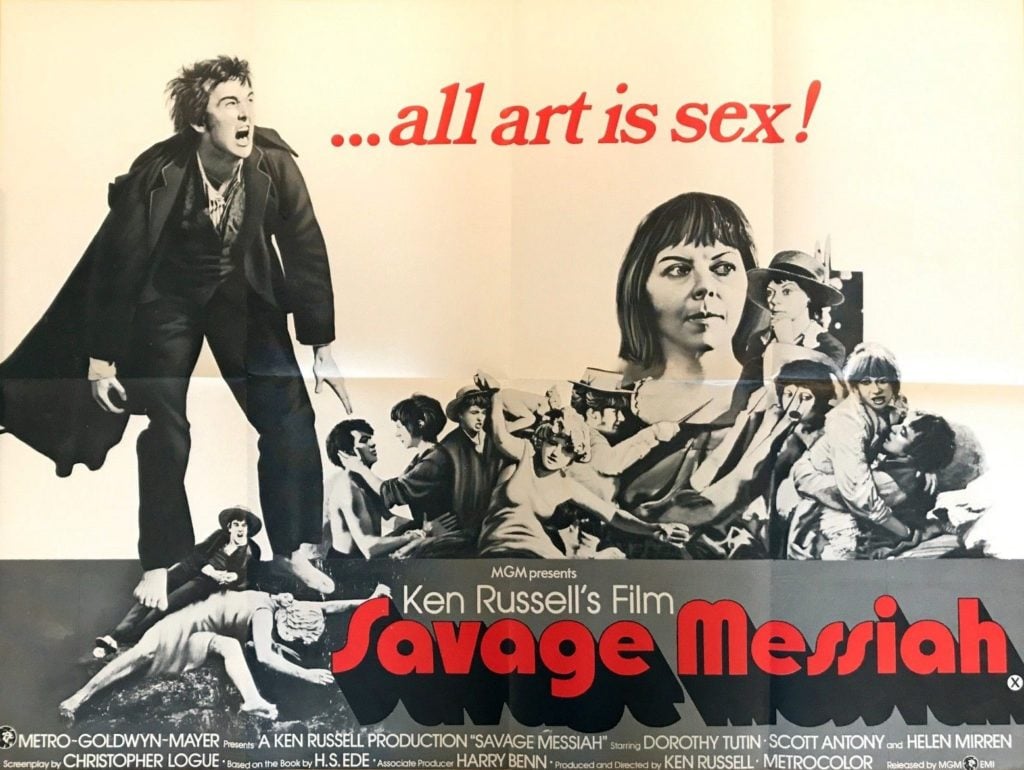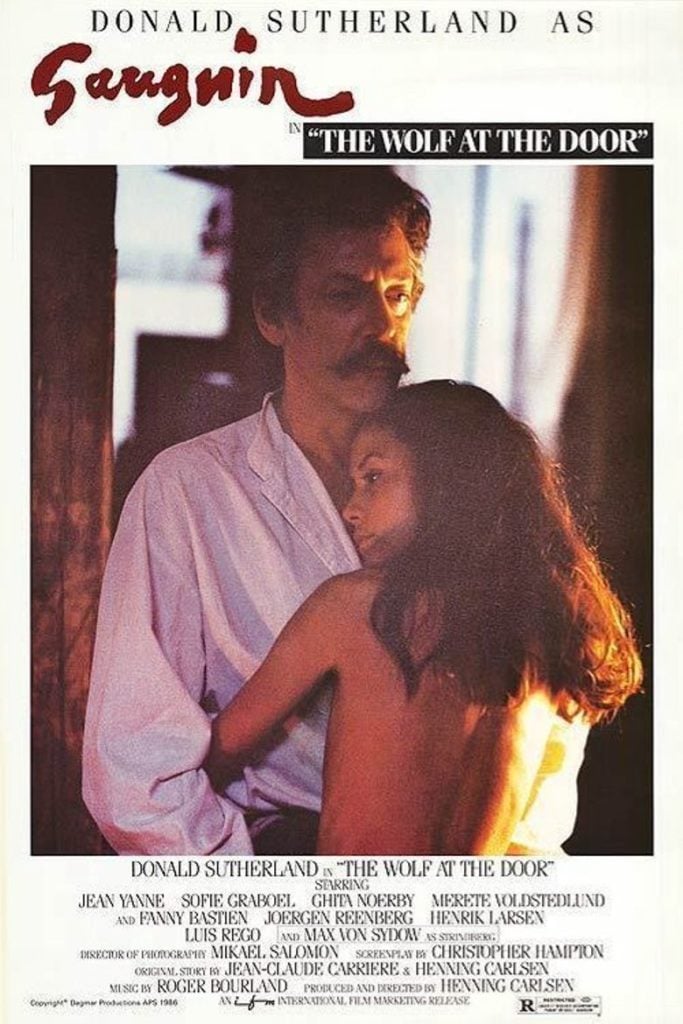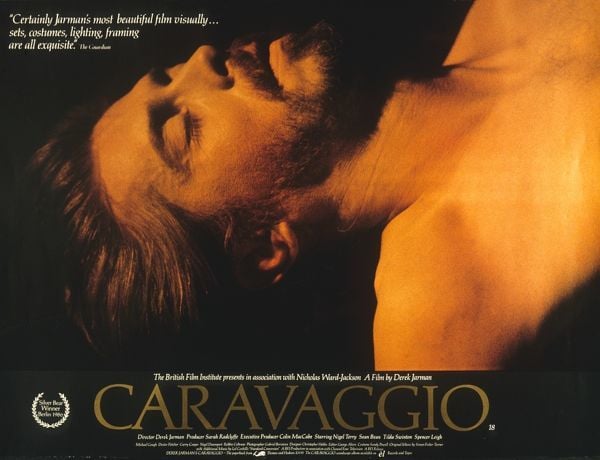Opinion
From Donald Sutherland’s Sleazy Gauguin to a Classic Caravaggio, How 3 Biopics Romanticize Artists’ (Often Unforgivable) Dark Sides
Part 3 of A History of Artist Biopics, on the '70s and '80s.

Part 3 of A History of Artist Biopics, on the '70s and '80s.

Ben Davis

As far as I can tell, the 1970s and the ‘80s were a fallow time for artist biopics, at least for those made in English. Hollywood’s mind was on other business, with producers busy consolidating the blockbuster genre film, starting with The Godfather in 1972 and gathering force thereafter with Jaws (1975) and Star Wars (1977).
Every artist biopic from the era I can find—and there aren’t many—hails from outside Hollywood. (I haven’t been able to secure copies of the Joyce Wieland-directed The Far Shore, a 1976 thriller about Canadian Group of Seven-affiliated artist Tom Thomson, or the 1980 TV movie Gauguin the Savage starring David Carradine.)
In a way, it makes sense that directors outside of the US, positioning themselves against the commercial American film industry, would be drawn to tales of heroic bohemian creative struggle against philistinism. Both British director Ken Russell’s Savage Messiah (1972) and Henning Carlsen’s Danish-French co-production Oviri (known as Wolf at the Door in the US) (1986) were at core about artist-heroes fighting to be “real” against a hostile mainstream culture. Speaking about Caravaggio (1986), Derek Jarman was very specific about seeing in art’s values an alternative to crass Hollywood materialism. (For context, Jarman’s experimental opus came out the same year as Top Gun and Ferris Bueller’s Day Off.)
This is the third part of a series on artist biopics. The first two are here and here.

Promotional poster for Savage Messiah (1972).
In terms of status within the legendarium of art history, the French-born Vorticist Henri Gaudier-Brzeska does not seem like an automatic candidate for the biopic treatment. In fact, he’s obscure enough that this film’s own official summary misidentifies him as “the bad boy of the Paris art scene,” even though he worked mainly in London and most of the film is set there. (The real-life Gaudier-Brzeska was associated with the British Vorticist movement, and helped found the London Group.)
So what is Ken Russell’s amusingly perplexing Savage Messiah about? The film’s spine is the relationship between the young wannabe artist and Sophie Brzeska, a melancholic writer 20 years his senior. For inscrutable reasons, they form a passionate bond, even though she insists that they never have sex. So even as they end up living together beneath a railway arch and taking each others’ surnames, they call themselves “brother” and “sister.” The painter, however, is randy as an ally cat, so she pays him to go out and sleep with prostitutes, though she is also caustically jealous.
What depth Savage Messiah conveys comes wholly from Sophie (Dorothy Tutin), who seems wounded enough by life to make the strange role work. Helen Mirren is also great as a (literally) bomb-throwing suffragette who also performs some truly memorable feminist performance art at a Vorticist cabaret that involves slashing up a replica of Goya’s Naked Maja with a knife (Mirren’s character, disappointingly, quickly drops feminism for nude modeling).
As for the main subject, Henri Gaudier-Brzeska, actor Scott Antony starts the “manic free spirit” routine with the knob turned to 11, and the volume never comes down.
Within moments of his first meeting with Sophie, he is perched atop a fountain, bellowing to passersby that Michelangelo is terrible because his sculptures have “no muscles! no holes!” and daring the cops to arrest him. At one point, he flings a marble torso through the window of a gallery to signify his contempt—only to have charges immediately forgiven when his dealer covers the damage as a down payment on the work, to the artist’s seething displeasure.
“Let me go!” Gaudier-Brzeska snarls as he wrestles with police after the vandalism. “I’m a hooligan! I don’t deserve my liberty…. Let me into this cell immediately!”
What It Contributes to the Genre: It’s actually fascinating how unremittingly inexplicable the character of Gaudier-Brzeska is in Savage Messiah. I guess you could say that this movie’s inability to give interior life to its artist shows how important that missing element is: It’s hard to be deeply moved by something that feels like a Monty Python sketch. On the other hand, Russell’s deliberate cartoonishness is an interesting way to leaven a tale of poverty and crushed dreams.

Promotional poster for Oviri, also known asThe Wolf at the Door (1986).
Donald Sutherland is actually pretty convincing as Paul Gauguin in this account of the Post-Impressionist’s two-year return to Paris (1893–95) between sojourns in Tahiti. He oozes a kind of earthy fanaticism that you think of when you think of the art, and Danish director Henning Carlsen’s film has an effective air of seedy European naturalism.
Those are the nice things you can say about Oviri. Pretty much everything about the actual substance of the film is just so jaw-droppingly wrong.
The film focuses on a 14-year-old Swedish girl named Judith (Sofie Gråbøl, who would go on, two decades later, to become an international star as detective Sarah Lund in the Nordic noir series The Killing) and her sexual awakening as she falls under the powerful sensual spell of the painter, who is crashing with her parents.
Early on, the curious girl queries the intriguing stranger about his life in Tahiti. He pulls out Spirit of the Dead Watching (1892), his painting of his nude Tahitian child bride laying on her belly. “You said she was happy,” Judith asks innocently. “Why does she look so sad?”
“It is because they truly know how to be happy, that they can be truly sad,” the painter says in a reverie, chewing on his pipe.
“How old was she?” Judith quizzes.
“Thirteen.”
“Younger than me!” Judith marvels.
Sutherland, keep in mind, was 52 here, only a little older than Gauguin would have been.
Soon, Sophie is modeling nude for him and eavesdropping on him having sex with models and girlfriends in the studio. It’s just very gross.
Max von Sydow appears in an extended cameo as Modernist playwright August Strindberg, whose (historically accurate) fanatical misogyny seems to be here mainly to make our hero’s free-living chauvinism a bit more modern by contrast.
To spoil the ending: After failing to make a big splash back in Paris, the destitute Gauguin decides to make for Tahiti again, selling off his prized Vincent van Goghs in a shabby auction that his friends help him rig. Judith visits the morose painter in his studio, begging him tenderly to let her run away with him to be his new child bride.
The fact that he turns her down, I think, is meant to be his redemption. “I’ve always felt like a father to you.” She then gives him a small bow made of trimmings from her public hair. “I’m very touched,” he says, and they kiss.
It’s so wrong.
What It Contributes: Oviri is so unsettling that I thought at first that maybe it was supposed to be a kind of exposé of the underbelly of the Gauguin mythology. I mean, The Moon and Sixpence, another Gaugin biopic, shows more awareness about the subject—and it was made 44 years earlier!
But no. The New York Times review from the day seems to find the treatment of women more colorful than unpleasant.
So what Oviri may contribute, really, is a perfect example of how the Artist-as-Great-Man myth is used to excuse a multitude of sins, and just how deeply that is baked into the myth-making of popular art history.

Promotional poster for Caravaggio (1986).
Caravaggio is probably the most widely known film by revered British experimental director Derek Jarman, who died in 1994 of AIDS-related complications. It’s a film oddly at once cold and soulful, shuffling between the dying Caravaggio (Noam Almaz) in Malta and memories of his tumultuous life in Rome.
At the level of narrative, it must be said, Caravaggio hits most of the beats that these stories have been hitting since Vasari. Tragic deathbed scene? Check. Precocious genius scene? Check. Tortured muse scene? Check. Confrontation with ignorant authority scene? Check.
It also, it must be said, softens Caravaggio for consumption, as these stories are wont to do. He’s a difficult man, sometimes dangerous and unlikable (the film does depict the infamous anecdote in which he attacked a waiter for giving him some artichokes he didn’t like), but he’s a lot more charismatic than the brutal scoundrel that Michelangelo Merisi da Caravaggio actually was.
Nevertheless, Jarman’s Caravaggio is special for two reasons.
First, it offers a wholeheartedly queer vision of Caravaggio. His main muse in the film is the brawny, brawling Ranuccio Tomassoni (Sean Bean), and possibly the highlight of the movie is a startlingly erotic knife fight between the two men. Jarman essentially imagines Caravaggio’s most infamous act—the 1606 killing of Ranuccio, supposedly over a disputed tennis match—as a tortured misunderstanding between lovers.
(In reality, Andrew Graham-Dixon thinks that Caravaggio killed Ranuccio in what amounted to a gang brawl over a prostitute; the painter was trying to castrate his enemy, and cut his femoral artery.)
The second reason Caravaggio is so great is style. It is an early example of Postmodern film, which in this case means that it deliberately introduces elements that are out-of-time. At the beginning of the movie, in the bare Malta room where the painter lays dying, Caravaggio feels naturalistic. But gradually, Jarman’s anachronisms pile up: a scornful critic clacking on a typewriter; Sean Bean fixing a motorcycle; a decadent party where ice cream is served and the outfits are out of the ‘20s….
The effect is subtly estranging, and slowly gives the film a hallucinatory feel.
What It Contributes: In interviews, Jarman was clear that he picked Caravaggio as a subject because, instead of painting idealized images of Biblical scenes, the artist shocked his contemporaries by putting the sacred in contemporary dress. The filmmaker drew a parallel between the saccharine piety Caravaggio was rejecting and Hollywood’s idealized but false image of the past. His own time-bending biopic, on the other hand, proposed an alternative mode that was, like his inspiration, both grittier and more contemporary.
It is worth saying that what makes Caravaggio work artistically is how deliberately the anachronisms are seeded, so that you sink into the fantasy and then are jolted into seeing how you’ve let your projections and desires get entangled with the story. But Hollywood figured out how to assimilate this Postmodern way of working just fine. What was once thought-provoking as a device in Jarman became very different in, say, the coked-up pastiche style of Baz Luhrmann’s Moulin Rouge 15 years later.